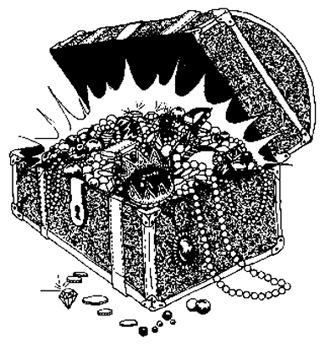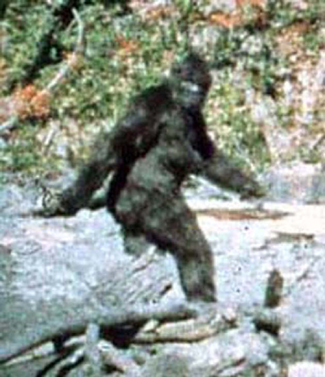Newaygo's Lost Treasure
 X marks the spot for a Newaygo Treasure
X marks the spot for a Newaygo Treasure
Just when I think I've heard it all in regards to Newaygo County's history, I came across a story about buried treasure. My first thought was, "A buried treasure of gold! What pirate sailed up the Muskegon River?" Actually, it turns out it is more of a Black Bart, wild-west type of tale. I came across some references to this story and like the pieces of a treasure map; it took me on a historical treasure hunt. The story seems to have originated in the October 1981 issue of "Lost Treasure" magazine (Copyright 1981, 1998 Lost Treasure, Inc.) but it may be a synthesis of several stories from the 19th century.
Story "One" states that a stagecoach carrying $74,000 in gold from a logging camp payroll was robbed in August 1874 somewhere near Traverse City. The five robbers buried the gold on the north shore of Benton Lake in Newaygo County (close to 100 miles southeast of the robbery). They put the gold into a cast iron stove and buried it between two tree stumps. The reason given for burying the gold was that it was far too heavy to carry. None of them returned to recover the loot out of fear of being caught. Some local "undesirable characters" were the main suspects but they were never proven to be involved. The dying man who told the story said he was the last of the five men involved in the robbery.
What a great story for an old Western novel or B movie, but it is just far too scripted to be believable. First, let's assume these robbers took the stagecoach all that way and ditched it on some old side trail that happened to pass this lake, just one of many small lakes in the region. Let's also suppose that they had an old cast iron stove available to put all the gold in before burying it. I wonder, "Why would they go all that way when there should have been plenty of secluded places near town to stash the loot? Plus if they had planned this robbery, why didn't they have a plan for how they'd spend it without getting caught?" Lucky the website with this information offered two other related stories that came from the Newaygo County Historical Society.
Story "Two", paraphrased from Harry L. Spooner's story in the Muskegon Chronicle, June 13th, 1925. Before lumbering began near Benton Lake (before the 1850's) a stagecoach ran from Pentwater (on Lake Michigan) to Big Rapids, skirting the north shore of the lake. One day it was held up and robbed, supposedly by Indians. A white settler was warned by the 'Indians' to leave so he buried his tools, left, and never returned.
Because Spooner was a local historian, "Story Two" has more credibility than "Story One" in Lost Treasure magazine, however, Spooner's story doesn't seem to relate well to "Story One". No payroll gold is mentioned and Indians would likely have wanted food and trade goods. Although these are obviously different stories, the earlier Newaygo story could have become mixed up with the later Traverse City story. Both have a stagecoach being robbed and both have items buried near Benton Lake that no one returned for.
Story "Three", quoted from the Newaygo County Historical Society. "Ed June tells the story . . . 'A man from Montana came to Benton Lake with a map showing where a treasure was buried. A bank in the west was robbed several years earlier ($72,000 in all) and the loot had been brought east and buried near Benton Lake. He explored all summer but was unable to locate it.' "
This story seems credible and even believable if the man from Montana was lying. The man was probably from Michigan and made up the Montana story to cover his true identity. Depending on when he showed up, he could have been one of the five hold-up men, or one of their friends or relatives, with a real map. Perhaps the gold was already gone or it wasn't at Benton Lake or maybe Mr. Montana found the gold, told everyone he couldn't find it, and went riding off into the sunset. Although this story relates to Story One, it doesn't add any useful facts to prove or disprove it. There is a Benton Lake in Montana, maybe this treasure hunter was just way off the mark!
Stories Two and Three were some meaty bones, but they still left my curiosity underfed. It was when I dug further that my research became more interesting. It seems that two important historical events happened in the region that may shed some light on Story One, which now seemed like more of a legend than ever. I found that the first train robbery in North America occurred in North Bend, Ohio in 1866 and the last stagecoach robbery happened in Michigan in 1889. Although the first train robbery was a state away, it must have been impressive enough to play on the public's mind for quite a while. More important would be the stagecoach robbery in Gogebic County (upper peninsula near Wisconsin) on August 26, 1889. The hold-up happened near Gogebic Lake, a rich man's resort area at that time. Reimund Holzhey, a bandit who had been robbing trains and stages in northern Wisconsin for the prior five months, robbed the stagecoach. Holzhey was captured on August 31, 1889, and was given a life sentence at Marquette Prison. Almost as far away from Newaygo as North Bend, the "last stagecoach robbery" has many similarities to our Benton Lake treasure story.
Although the stagecoach robbery in Gogebic County happened 15 years after the Benton Lake story supposedly occurred and it was a single robber (not a group of five), it did happen on a stage line near a lake, in August, in an area northwest of Newaygo. This story was labeled as the last stagecoach robbery and probably resurfaced when Holzhey was paroled in 1914 and again in 1952 when he committed suicide. It seems likely the Benton Lake treasure legend is a composite story that developed sometime between Spooner publishing his story in 1925 and Holzhey's suicide in 1952. Of course, not having done any deep research into old newspapers or court records, it's possible there is a treasure of gold at Benton Lake, one that a good metal detector should be able to pick up.
Local history is like lost treasure in that it is buried, one has to follow clues and then dig to find it, and it is an adventure searching for it. Often when pursuing history, and digging through various informational resources, the side trails become the paths of discovery. Taking an alternate route will reveal sights and scenes that were previously unknown and occasionally this will spark a thought or an idea that expands the consciousness. That 'spark' is the treasure I get from studying local history. It isn't about the factuality of an event from the past or about evidence in support of, or against, a now legendary story, but about the personal change of perspective one gains when doing the research. This is how I feel about this local story of a lost fortune of buried gold just waiting to be found.
Comment about this article on the
Epress Forum Board
.
|
|
Michigan Bigfoot
 Bigfoot, a figment of reality?
Bigfoot, a figment of reality?
Some years ago I saw a quick local news report about a bigfoot sighting right on US 131 near Big Rapids. Apparently a couple of young men hit a hairy, upright animal with their vehicle. The animal glanced off the front end, hit the ground, then got up and ran on off on two legs. They were certain it wasn't a bear and shook up enough to notify local authorities. Of course, such an incredible story related by a couple of local teenagers has very little credibility and the old "black bear" theory was applied. Upon hearing this story I thought to myself, "Bigfoot in my own backyard!" and remembered hearing bizarre screams while camping in the woods many years ago. The seed was planted in my imagination by numerous Sasquatch stories I've heard all my life and a local report was enough to cause it to sprout. Since that time I check out reports of hairy hominids whenever they appear in the media.
Now, don't get me wrong, I'm not really a true believer and tend toward high skepticism. Most sightings of "monsters and beasties" are misidentified but naturally occurring species (what I heard in the woods was screech owls and not bigfoot). Having said that I must admit that one night, driving down my road, I saw what appeared to be an eight-foot-tall, hairy upright creature standing by the road, waving as I drove past! I was shocked and horrified until I was right on it and realized it was a few bushes and a tree limb in the shadows. I had to laugh at myself for such a foolish idea, but I had to think about why I would superimpose the shape of a bigfoot on the shadows in the road. I should be more wary of a deer, raccoon, dog, or another critter shape, but after having bigfoot on the brain, every shadow had the potential to become the hairy brute.
I like to be open-minded and could believe in Bigfoot even though there is no undeniable solid evidence to support that belief. The most credible reports are sincere and believable despite the lack of physical evidence, however, the likelihood of a huge wild ape-man-beast wandering around almost every state in the union is about zero. Then again, there is some evidence that has been scrutinized by legitimate experts and many compelling facts are coming to light. I never believed one way or the other but I am tending more toward cautious belief. I'm not saying the big guys are here in Michigan or down in Ohio or Indiana, but they may exist in small pockets around the globe. Here are statements from some regional reports I dug up and some compelling evidence for Bigfoot's existence around North America.
Source: Chicago Tribune
Date: October 30, 1990
Location: Bay City, Michigan
"On Sept. 28, two hikers told the Oscoda County Sheriff's Department they spotted a tall, hairy creature in Foley Swamp in Huron National Forest. Art Kapa of Mayville, a Bigfoot investigator for 21 years, said he gets annual reports of sightings in Luzerne, Mio and Lewiston. 'The area is full of swamp, valleys and excellent hiding places,' "
Source: Idaho Statesman Boise (UPI)
Date: November 22, 1981
Location: Yale, Mich.
"Tina Barone, 13, said she and her sister, Roxanne, 12, went to the barn to do chores. 'Roxanne was scared to go into the barn because she'd heard noises before,' Tina said. 'I said I would go in first, so I reached in for the light. I felt fur. At first I thought it was a goat or something, so I took my glove off and I touched it again . . . It was tall with red eyes and big and black and furry and stood on two legs. It had a deep growl.' The girl's cousin David, 18, got his 16-gauge shotgun to scare the creature away. 'When it stood there and looked at me, it didn't know what to do and I didn't either,' said Barone. 'It's unbelievable. Its big. It was some kind of animal but I can't describe what. It was about 6 feet; 6 or 7 feet. I didn't shoot to kill, I just shot in the air to scare it away. It ran into the woods, making a funny noise.' "
Experts support North American Bigfoot Evidence
Source: Theo Stein, Denver Post Writer
Date: 14 January 2001
Location: Around the U.S.
"One of the few academic Bigfoot researchers is physical anthropologist Jeff Meldrum, an Idaho State University professor who has examined hundreds of claimed footprints from Bigfoot, . . . more than 100, he said, represent the trace of an unknown animal with a big, flat foot and five toes. . . Rather than simply an enlarged human foot, Meldrum said, the Sasquatch foot displays a unique combination of recognizably different anatomic features to solve the problem of two-footed locomotion."
". . . Meldrum received unexpected support from Chilcutt, the fingerprint and forensics expert who's also one of the world's few authorities on primate skin patterns, or dermatoglyphics."
"Chilcutt developed an expertise in primate skin patterns as an offshoot of his ongoing study of the human fingerprint. His archive of more than 1,000 ape-skin impressions prints he collected from tranquilized orangutans, chimpanzees and gorillas is the largest such collection in the world."
"But when he examined . . . Meldrum's collection, Chilcutt found two casts with coarse ridge patterns similar to each other but different from humans or known great apes. One cast of a footprint discovered in Washington's Blue Mountains in 1985 astonished him with the distinctive puckered scars of several healed wounds."
"Chilcutt . . . said the skin impressions he has identified in the Blue Mountains track were consistent with those found in a Bluff Creek track from 1967. "We're talking about 18 years and 700 or 800 miles apart," he said. After he spoke about his finding on National Public Radio, a sheriff's deputy sent in a cast of a track he'd found in Georgia in 1977. Same pattern. In mid-November, Chilcutt examined . . . heel impressions from the body imprint discovered in Washington. He said they match the other four examples he's identified."
Comment about this article on the
Epress Forum Board
.
|



